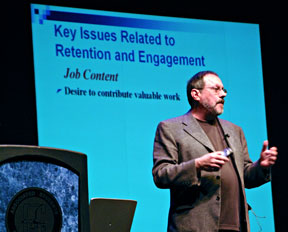Futurist Jay Jamrog spoke about the changes in the workforce at the second installment of the 50th Anniversary Speakers Series last Thursday at the Burnight Center Theatre.
The last speaker in the series, former head of League of Innovation Dr. Mark Milliron, will speak at the Burnight Center Theatre on Mar. 30.
Jamrog, executive director of Human Resource Institute, a non-profit research organization, was first seen by college President Noelia Vela and others at a community college association conference in 2005.
“Yes, he has a crystal ball. No, he’s not leaving one, but… he is willing to share glimpses into it,” Vela said.
Jamrog spoke to the crowd of about a hundred on the “War for Talent,” a forecast which includes three storms set to procure in 10-15 years.
According to Jamrog, the “half-life” of occupational skills,and the rate that skills become obsolete, is decreasing.
“Today, fully half of… what an engineering student learns as a freshman is obsolete by the time (he or she is) a senior,” said Jamrog, adding that it is up to educational institutions to bridge this gap.
The skill deficit in the workplace that results from these changes is the first component of the storm.
If the current rates of labor growth and creation of new jobs continue, 1.1 percent and 2- 2.5 percent a year respectively, there will be a labor shortage in the United States forming the second part of the storm.
Adding to this is the fact that for four decades, workers have been retiring earlier and earlier.
The third part is a deficiency of knowledge workers.
These are workers between the ages of 35 to 54 with experience in the industry.
With 43 percent of the workforce eligible to retire in the next 10 years, Jamrog believes this could become a problem.
Jamrog also cites technologies that may develop to cover the skill deficit in the future.
“Because of technology, (factories) will probably only have two employees. There will be a man and a dog. The man will be there to feed the dog and the dog will be there to make sure the man doesn’t touch anything,” Jamrog said.
“The challenges that Jamrog presented are right on,” said Francine DeFrance, dean of humanities and social sciences.
DeFrance also said that educators need to seek new ways that they can relate, connect-to and mentor students.
Jamrog also spoke about the “generation markers” of each generation studied in the institute’s Workforce 2000 project, such as the Great Depression and Civil Rights for the Baby Boomers.
? Depression Generation: born 1927- 1945
? Baby Boomers: born 1946- 1964
? Baby Bust: born 1965- 1983
? Baby Boomlet: born after 1984
According to Jamrog, with our extremely technology-based Baby Boomlets, educators need to anticipate the need for relationships.
“The more high-tech they become, the more high-touch they want,” he said.
While workers in earlier generations were loyal to their employers, workers of later generations are more loyal to their profession. However, they also want a support network.
The Boomlets are the first “true green generation,” according to Jamrog.
He believes that Boomlets enjoy going out on beach cleanups and the like, something that Paulo Amaral, student body president, said he relates to.
“I know many individuals (of the) same age who care about the environment,” he said.
Vela believes that the school is doing its part to help “mold” this new generation.
“I think we are responding well to the Boomlet generation. We have a rich and consistent community,” she said, citing student involvement in clubs and student government.
She notes, however, that formation of groups for employees of the college need to be reflected on.








